
Teaching children the Real Presence
Each spring parishes celebrate a First Communion Mass with a new group of children. This is a special day for them. They are donned in their finest clothes while they participate in the liturgy, and a photographer snaps a photograph of each child receiving Jesus for the first time. Yet a Pew Research Center study done in 2019 showed that 69 percent of Catholics believed the bread and wine to be “symbols of the body and blood of Jesus Christ” rather than the True Presence. What happened?
Jesus first taught of the True Presence, recorded in John 6:54: “Whoever eats my flesh and drinks my blood has eternal life, and I will raise him on the last day.” This teaching was shocking to His followers, and some left Him fearful of what was coming next.
This undoubtedly can get lost in translation when teaching young children about the Eucharist. It is very difficult to teach this fundamental truth of our faith especially if we take a theological approach at such a young age. Children tend to think very concretely, think of things as black and white, or have a magical way of thinking. We can come up with analogies or activities to do with them to try and explain transubstantiation, but in doing this, we may risk having them grow up to believe that the Eucharist is “just a symbol.”
What is missing in the teaching of the sacrament is the invitation to open hearts and experience for themselves Christ’s sacrifice. According to the Catechism of the Catholic Church, “The Eucharist is the source and summit of the Christian life.” As catechists, do we always behave as though this is true?
The Church was born primarily of Christ’s love for us. Christ’s gift of Himself was anticipated in the Institution of the Eucharist at the Last Supper and later bestowed on the cross. That love, that sacrifice, is re-presented in the Eucharist at Mass. If we want children to grow up to understand the True Presence, we must guide them to Christ by teaching them about the Mass and encouraging families to attend Mass and be models of reverence.
The Mass and Eucharistic Adoration teach on their own. When the host is consecrated bells ring, the priest bows, and when the Eucharist is exposed, all of that itself is a pedagogy in reverence, and the reverent actions we do become a pedagogy unto themselves.
I recall as a teenager going to a Mass with my grandparents and watching as two people lay prostrate in front of the tabernacle and then later knelt to receive communion on the tongue. This was foreign to me, and I asked my grandmother why they did this. Her response was, “Because they are receiving Jesus and it’s a sign of respect.” They are receiving Jesus. Jesus can be worshipped. One cannot worship a symbol in the form of a wafer. I realized at that moment that there was something special happening; something that could not be conveyed in my religion textbook.
Our students, as well as their parents, need to experience the configuration of the purist, most plentiful self-gift that there is — the sacrifice of the Word made flesh, Christ’s passion! To do this, we regularly speak of the consecrated host as Jesus Christ. We attend Mass. We genuflect in front of the tabernacle. We bow before receiving Jesus at Communion. We kneel in prayer and give thanks for the gift we have just received. At this imitative stage of their lives, children need to see how others act, and their understanding will come later.
The focus of our lessons on the Eucharist should be about Jesus’ love and ultimate sacrifice for us. His body, blood, soul and divinity, the gift of self is what is present in the Eucharist. And for this, we give thanks (eucharista) at Mass. In that thanksgiving is an openness of heart and in that openness of heart, we can truly understand what we are doing at Mass. Having received communion and being configured to Christ’s gift allows us to realize we are one with Him when we receive. He is truly present.
—Valerie Parzyck is director of religious education and youth ministry for St. John Vianney Parish in South Burlington.
—Originally published in the Fall 2022 issue of Vermont Catholic magazine.

